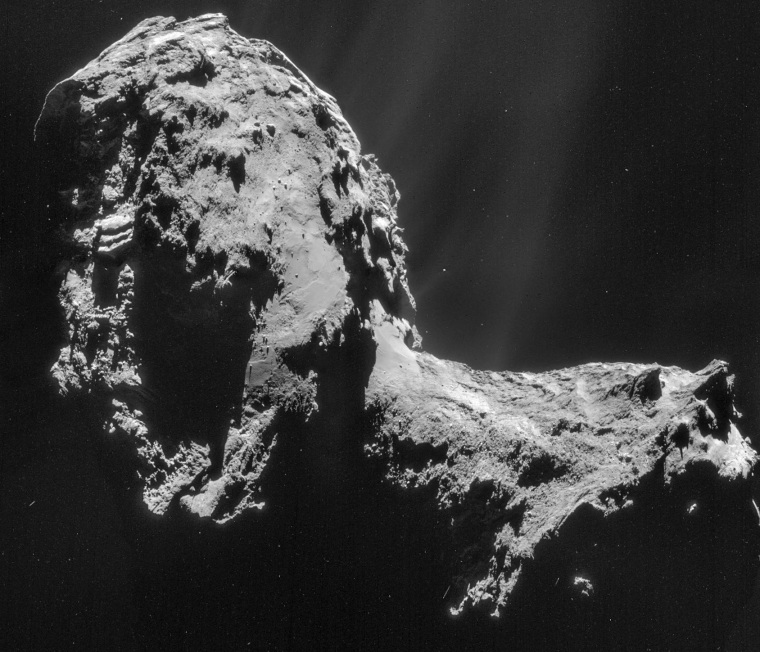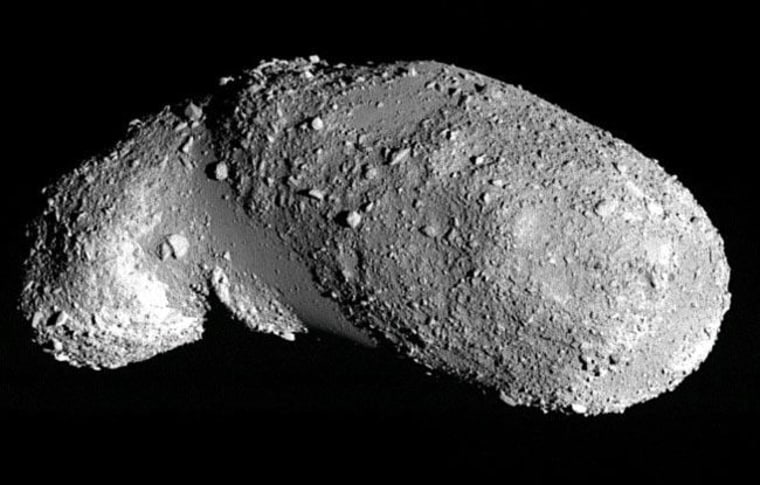An analysis of water vapor emanating from the comet being tailed by the Rosetta spacecraft has shown that such comets couldn't have been the source of the water in Earth's oceans, and that suggests our H2O was more probably delivered by asteroids, during a time when they were much icier than they are now.
That's the conclusion drawn from observations made by Rosetta's ROSINA instrument suite in the weeks leading up to last month's unprecedented landing on Comet 67P/Churyumov-Gerasimenko. The ROSINA results were published online Wednesday by the journal Science.
"It's a nice start to this phase of the mission where we really are full science, and there's going to be a lot more from Rosetta," said Matt Taylor, project scientist for the European Space Agency's $1.7 billion Rosetta mission.
The key finding has to do with the balance of two types of hydrogen bound up in those H2O molecules. The most common type of hydrogen has one proton in the atom's nucleus — but on Earth, about three molecules out of 20,000 instead have deuterium, a different hydrogen isotope with a proton and a neutron in the nucleus. Measuring the deuterium/hydrogen ratio, or D/H ratio, is one of the primary tasks for ROSINA.
As the car-sized Rosetta spacecraft homed in on Churyumov-Gerasimenko, ROSINA got an increasingly precise fix on the D/H ratio in water molecules wafting off the comet. The data showed that there were about three times as many deuterium atoms as there would be in an earthly sample.
Decades-long debate
Those findings factored into a long-running debate over one of the big mysteries of the solar system's formation: Where did Earth's water come from?
Planetary scientists say the freshly minted Earth was so hot that it couldn't have retained as much water as our planet has today. Instead, they say most of the water had to have been delivered by icy bodies that slammed into Earth well after its formation. Could those bodies have been comets from the solar system's icy edge?
The first good opportunity to test that hypothesis came in 1986, when ESA's Giotto probe flew past Halley's Comet, an iceball that originated in the solar system's vast Oort Cloud. Giotto's readings added up to a D/H ratio that was about twice that of Earth's water — and that led scientists to rule out Oort Cloud comets.

Then, in 2011, ESA's Herschel probe observed Comet 103P/Hartley 2 — which had its genesis closer to the sun, in a region known as the Kuiper Belt. Such comets are known as Jupiter family comets. Scientists found that Hartley 2's D/H ratio was close to the level for Earth's oceans. All of a sudden, the comet water hypothesis was back in fashion. Rosetta's scientists looked forward to finding out whether Churyumov-Gerasimenko, which is also a Jupiter family comet, would confirm the hypothesis.
The results announced on Wednesday indicate that there can be quite a bit of variation in the signature of water from Jupiter family comets — but based on the ROSINA analysis, it would be hard to explain how cometary water could have been the main contributor to Earth's oceans.
"Ten years ago, I would not have been surprised at all by this result, because that's what I expected," said the University of Bern's Kathrin Altwegg, principal investigator for the ROSINA instrument suite. "But then three years ago we got this Hartley 2 measurement, and that was a real big surprise. And now we are back to what I actually expected."
Returning to the prime suspect
The findings from ROSINA leave the asteroids of the early solar system as the best candidates for furnishing Earth's water. Based on the cratering rates observed on the moon, scientists have figured out that our planet was hit by a wave of cosmic impacts during a period known as the Late Heavy Bombardment — about 800 million years after the solar system was formed.
"Today, asteroids have very little water, that's clear, but that was probably not always the case. The Late Heavy Bombardment was 3.8 billion years ago, and at that time, asteroids could well have had much more water than they have today," Altwegg said. "They have just lived in the vicinity of the sun for 4.6 billion years, so they have certainly lost their water due to the sun, due to the heat. But to start with, they could have had much more water than they have now."
Over the years, planetary scientists have measured the D/H ratio in a wide variety of meteorites that fell to Earth, presumably after being struck off from asteroids. Those measurements are in good agreement with the ratio found on Earth — and that's why ancient asteroids are the prime suspects in the mystery surrounding the genesis of our planet's oceans.

Adam Sarafian, a geophysicist at Woods Hole Oceanographic Institution who was not involved in the ROSINA study, said the scenario suggested by Altwegg is consistent with what he has found in his own research into carbonaceous chondrites, a particular type of asteroid.
"That meshes very well with the results of our recent paper," Sarafian told NBC News. "We found that the inner solar system got its water from carbonaceous chondrites. It's a great confirmation."
The case need not be closed just yet: If Japan's Hayabusa 2 probe brings back samples from a carbon-rich asteroid called 1999 JU3, that would provide "good answers" to scientists' questions, Altwegg said. And Rosetta is just now hitting its prime: The spacecraft is expected to send back oceans' worth of data as it follows Churyumov-Gerasimenko around the sun over the next year or so.
Altwegg is among 32 researchers listed as authors of "67P/Churyumov-Gerasimenko, a Jupiter Family Comet With a High D/H Ratio." An earlier version of this report botched the distinction between hydrogen and deuterium. Deuterium has a proton and a neutron. If it had two protons, it would be helium. Thanks to @Farlee for setting us straight.